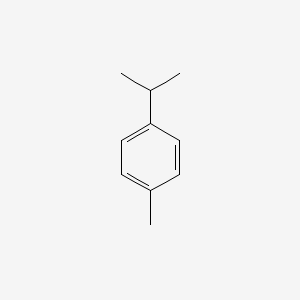| MeSH term | MeSH ID | Detail |
|---|---|---|
| Carbon Tetrachloride Poisoning | D002252 | 12 associated lipids |
| Chemical and Drug Induced Liver Injury | D056486 | 39 associated lipids |
| Dermatomycoses | D003881 | 17 associated lipids |
p-Cymene
P-cymene is a lipid of Prenol Lipids (PR) class. P-cymene is associated with abnormalities such as Abnormal shape. The involved functions are known as Binding (Molecular Function), inhibitors and Oxidation. P-cymene often locates in Cell membrane. The associated genes with p-Cymene are Chromatin, Homologous Gene and ethylbenzene dehydrogenase. The related lipids are Steroids.
Cross Reference
Introduction
To understand associated biological information of p-Cymene, we collected biological information of abnormalities, associated pathways, cellular/molecular locations, biological functions, related genes/proteins, lipids and common seen animal/experimental models with organized paragraphs from literatures.
What diseases are associated with p-Cymene?
p-Cymene is suspected in Abnormal shape and other diseases in descending order of the highest number of associated sentences.
Related references are mostly published in these journals:
| Disease | Cross reference | Weighted score | Related literature |
|---|
Possible diseases from mapped MeSH terms on references
We collected disease MeSH terms mapped to the references associated with p-Cymene
PubChem Associated disorders and diseases
What pathways are associated with p-Cymene
There are no associated biomedical information in the current reference collection.
PubChem Biomolecular Interactions and Pathways
Link to PubChem Biomolecular Interactions and PathwaysWhat cellular locations are associated with p-Cymene?
Visualization in cellular structure
Associated locations are in red color. Not associated locations are in black.
Related references are published most in these journals:
| Location | Cross reference | Weighted score | Related literatures |
|---|
What functions are associated with p-Cymene?
Related references are published most in these journals:
| Function | Cross reference | Weighted score | Related literatures |
|---|
What lipids are associated with p-Cymene?
Related references are published most in these journals:
| Lipid concept | Cross reference | Weighted score | Related literatures |
|---|
What genes are associated with p-Cymene?
Related references are published most in these journals:
| Gene | Cross reference | Weighted score | Related literatures |
|---|
What common seen animal models are associated with p-Cymene?
There are no associated biomedical information in the current reference collection.
NCBI Entrez Crosslinks
All references with p-Cymene
Download all related citations| Authors | Title | Published | Journal | PubMed Link |
|---|---|---|---|---|
| Amiri H | Volatile constituents and antioxidant activity of flowers, stems and leaves of Nasturtium officinale R. Br. | 2012 | Nat. Prod. Res. | pmid:21815727 |
| Rudbäck J et al. | α-Terpinene, an antioxidant in tea tree oil, autoxidizes rapidly to skin allergens on air exposure. | 2012 | Chem. Res. Toxicol. | pmid:22250748 |
| Verma RS et al. | Volatile constituents of Origanum vulgare L., 'thymol' chemotype: variability in North India during plant ontogeny. | 2012 | Nat. Prod. Res. | pmid:22011270 |
| Weerakoon KA and Chin BA | A chemical switch for detecting insect infestation. | 2012 | Pest Manag. Sci. | pmid:22262532 |
| Bairwa R et al. | Trachyspermum ammi. | 2012 | Pharmacogn Rev | pmid:22654405 |
| Paul LE et al. | Investigation of the reactivity between a ruthenium hexacationic prism and biological ligands. | 2012 | Inorg Chem | pmid:22221272 |
| Singh T et al. | Synthesis, reactivity studies, structural aspects, and solution behavior of half sandwich ruthenium(II) N,N',N''-triarylguanidinate complexes. | 2012 | Inorg Chem | pmid:22148465 |
| Xie G et al. | p-Cymene protects mice against lipopolysaccharide-induced acute lung injury by inhibiting inflammatory cell activation. | 2012 | Molecules | pmid:22772811 |
| Kiralan M | Volatile compounds of black cumin seeds (Nigella sativa L.) from microwave-heating and conventional roasting. | 2012 | J. Food Sci. | pmid:22515239 |
| Ackermann L et al. | Well-defined ruthenium(II) carboxylate as catalyst for direct C-H/C-O bond arylations with phenols in water. | 2012 | Org. Lett. | pmid:22494272 |
| Ludwig G et al. | Highly active neutral ruthenium(II) arene complexes: synthesis, characterization, and investigation of their anticancer properties. | 2012 | J. Inorg. Biochem. | pmid:22698819 |
| Giweli A et al. | Antimicrobial and antioxidant activities of essential oils of Satureja thymbra growing wild in Libya. | 2012 | Molecules | pmid:22538487 |
| Ali IB et al. | Variation of volatiles in Tunisian populations of Thymbra capitata (L.) Cav. (Lamiaceae). | 2012 | Chem. Biodivers. | pmid:22782875 |
| Sabzghabaee AM et al. | Clinical evaluation of the essential oil of "Satureja Hortensis" for the treatment of denture stomatitis. | 2012 | Dent Res J (Isfahan) | pmid:22623938 |
| Miladinović DL et al. | Investigation of the chemical composition-antibacterial activity relationship of essential oils by chemometric methods. | 2012 | Anal Bioanal Chem | pmid:22389175 |
| Zheljazkov VD et al. | Distillation time alters essential oil yield, composition, and antioxidant activity of male Juniperus scopulorum trees. | 2012 | J Oleo Sci | pmid:23018851 |
| Singh V et al. | Direct analysis in real time by mass spectrometric technique for determining the variation in metabolite profiles of Cinnamomum tamala Nees and Eberm genotypes. | 2012 | ScientificWorldJournal | pmid:22701361 |
| Amiri H | Essential oils composition and antioxidant properties of three thymus species. | 2012 | Evid Based Complement Alternat Med | pmid:21876714 |
| Kim E and Park IK | Fumigant antifungal activity of Myrtaceae essential oils and constituents from Leptospermum petersonii against three Aspergillus species. | 2012 | Molecules | pmid:22945026 |
| Bourgou S et al. | Changes of peel essential oil composition of four Tunisian citrus during fruit maturation. | 2012 | ScientificWorldJournal | pmid:22645427 |
